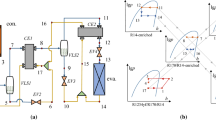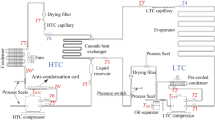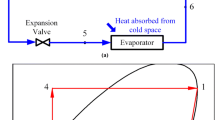Abstract
In this paper, an ejector enhanced two-stage auto-cascade refrigeration cycle (EARC) using ternary mixture R600a/R32/R1150 is proposed for application of −80°C freezing. In EARC cycle, an ejector was employed to recover the expansion work in the throttling processes and lifted the suction pressure of the compressor. The performances of the ejector enhanced two-stage auto-cascade refrigeration cycle and conventional auto-cascade refrigeration cycle (CARC) were compared using thermodynamic analysis methods. The influences of the important operation parameters including mass fraction ratio of the mixture, fluid quality at the second separator inlet, condensation temperature, evaporation temperature, and expansion ratio of expansion valve on the performances of EARC cycle were discussed in detail. The results indicate that ternary mixture R600a/R32/R1150 has the optimal mass fraction ratio of 0.45/0.2/0.35 with respect to the maximum COP. The EARC cycle yields higher performance than the CARC cycle in terms of COP, exergy efficiency and volumetric refrigeration capacity. And 4.9%–36.5% improvement in COP and 6.9%–34.3% higher exergy efficiency could be obtained in EARC cycle comparing with CARC cycle. The finding of this study suggests that the EARC cycle has a promising application potential for low temperature freezing.
Similar content being viewed by others
Explore related subjects
Discover the latest articles and news from researchers in related subjects, suggested using machine learning.Abbreviations
- COP :
-
cooling coefficient of performance
- EPR :
-
expansion ratio of throttle valve
- ex :
-
specific exergy/kJ·kg−1
- h :
-
specific enthalpy/kJ·kg−1
- MFR :
-
mass fraction ratio of mixture components
- ṁ :
-
mass flow rate/kg·s−1
- P :
-
pressure/kPa
- Q e :
-
refrigeration capacity/W
- Q h :
-
heat capacity rejected at condenser/W
- q v :
-
volumetric refrigeration capacity/kJ·m−3
- r P :
-
pressure lift ratio
- s :
-
specific entropy/kJ·kg−1·K−1
- T :
-
temperature/°C
- W COM :
-
compressor input power/W
- x :
-
fluid quality
- η :
-
efficiency
- μ :
-
entrainment ratio
- π :
-
compression ratio
- ϕ :
-
exergy destruction ratio
- CoM:
-
compressor
- CON:
-
condenser
- d:
-
diffuser of ejector
- dis:
-
discharge temperature
- EC:
-
evaporation condenser
- EJE:
-
ejector
- EV:
-
evaporator
- EXP:
-
expansion valve
- e:
-
evaporation
- i:
-
inlet
- is:
-
isentropic procedure
- MIX:
-
Mixing process before ejector nozzle
- m:
-
mixing chamber of ejector
- n:
-
nozzle of ejector
- o:
-
outlet
- SEP:
-
separator
- s:
-
secondary fluid
- sys:
-
system
- tot:
-
total exergy destruction
- 1–16:
-
state points of refrigerant
References
Chakravarthy V.S., Shah R.K., Venkatarathnam G., A review of refrigeration methods in the temperature Range 4–300 K. Journal of Thermal Science and Engineering Applications, 2001, 3(2): 020801–020819.
Kim S.G., Kim M.S., Experiment and simulation on the performance of an autocascade refrigeration system using carbon dioxide as a refrigerant. International Journal of Refrigeration, 2002, 25: 1093–1101.
Du K., Zhang S., Xu W., Niu X., A study on the cycle characteristics of an auto-cascade refrigeration system. Experimental Thermal and Fluid Science, 2009, 33: 240–245.
Wang Q., Liu R., Wang J., Chen F., Han X., Chen G., An investigation of the mixing position in the recuperators on the performance of an auto-cascade refrigerator operating with a rectifying column. Cryogenics, 2012, 52: 581–589.
Wang Q., Li D.H., Wang J.P., Sun T.F., Han X.H., Chen G.M., Numerical investigations on the performance of a single-stage auto-cascade refrigerator operating with two vapor-liquid separators and environmentally benign binary refrigerants. Applied Energy, 2013, 112: 949–955.
Yan G., Hu H., Yu J., Performance evaluation on an internal auto-cascade refrigeration cycle with mixture refrigerant R290/R600a. Applied Thermal Engineering, 2015, 75: 994–1000.
Xu X., Liu J., Cao L., Mixed refrigerant composition shift due to throttle valves opening in auto cascade refrigeration system. Chinese Journal of Chemical Engineering, 2015, 23: 199–204.
Zhang L., Xu S., Du P., Liu H., Experimental and theoretical investigation on the performance of CO2/propane auto-cascade refrigerator with a fractionation heat exchanger. Applied Thermal Engineering, 2015, 87: 669–677.
Bai T., Yan G., Yu J., Experimental investigation of an ejector-enhanced auto-cascade refrigeration system. Applied Thermal Engineering, 2018, 129: 792–801.
Sivakumar M., Somasundaram P., Exergy and energy analysis of three stage auto refrigerating cascade system using Zeotropic mixture for sustainable development. Energy Conversion and Management, 2014, 84: 589–596.
Rui S., Zhang H., Zhang B., Wen D., Experimental investigation of the performance of a single-stage auto-cascade refrigerator. Heat and Mass Transfer, 2015, 52: 11–20.
Bai T., Yan G., Yu J., Experimental investigation on the concentration distribution behaviors of mixture in an ejector enhanced auto-cascade refrigeration system. International Journal of Refrigeration, 2019, 99: 145–152.
Sreenivas B., Nayak H.G., Venkatarathnam G., Relationship between composition of mixture charged and that in circulation in an auto refrigerant cascade and a J-T refrigerator operating in liquid refrigerant supply mode. Cryogenics, 2017, 81: 42–46.
Narasimhan N.L., Venkatarathnam G., A method for estimating the composition of the mixture to be charged to get the desired composition in circulation in a single stage JT refrigerator operating with mixtures. Cryogenics, 2010, 50: 93–101.
Elbel S., Lawrence N., Review of recent developments in advanced ejector technology. International Journal of Refrigeration, 2016, 62: 1–18.
Lawrence N., Elbel S., Experimental investigation of a two-phase ejector cycle suitable for use with low-pressure refrigerants R134a and R1234yf. International Journal of Refrigeration, 2014, 38: 310–322.
Jeon Y., Jung J., Kim D., Kim S., Kim Y., Effects of ejector geometries on performance of ejector-expansion R410A air conditioner considering cooling seasonal performance factor. Applied Energy, 2017, 205: 761–768.
Manjili F.E., Cheraghi M., Performance of a new two-stage transcritical CO2 refrigeration cycle with two ejectors. Applied Thermal Engineering, 2019, 156: 402–409.
Rostamnejad H., Zare V., Performance improvement of ejector expansion refrigeration cycles employing a booster compressor using different refrigerants: Thermodynamic analysis and optimization. International Journal of Refrigeration, 2019, 101: 56–70.
Lee J., Baek S., Jeong S., Investigation of the ejector application in the cryogenic Joule-Thomson refrigeration system. Energy, 2018, 165: 269–280.
Bai T., Yan G., Yu J., Experimental research on the pulldown performance of an ejector enhanced auto-cascade refrigeration system for low-temperature freezer. Energy, 2018, 157: 647–657.
Breidenich C., Magraw D., Rowley A., James W.R., The Kyoto protocol to the United Nations framework convention on climate change. American Journal of International Law, 1998, 92(2): 315–331.
Schulz M., Kourkoulas D., Regulation (EU) No 517/2014 of The European Parliament and of the council of 16 April 2014 on fluorinated greenhouse gases and repealing Regulation (EC) No 842/2006. Official Journal of European Union, 2014, No. 517: L150.
Calm J.M., Hourahan G.C., Refrigerant data update. HPAC Engineering, 2007, 79(1): 50–64.
Lemmon E.W., Huber M.L., Mclinden M.O., NIST Standard Reference Database 23: Reference Fluid Thermodynamic and Transport Properties-REFPROP. 10.0, NIST NSRDS, 2018.
Silvio D.O.J., Exergy: production, cost and renewability. Springer Science & Business Media, 2012.
Bai T., Yu J., Yan G., Advanced exergy analyses of an ejector expansion transcritical CO2 refrigeration system. Energy Conversion and Management, 2016, 126: 850–861.
Liu F., Groll E.A., Ren J., Comprehensive experimental performance analyses of an ejector expansion transcritical CO2 system. Applied Thermal Engineering, 2016, 98: 1061–1069.
Acknowledgements
The work presented in this paper is financially supported by National Natural Science Foundation of China (NSFC) under the grant No. 51806160 and China Postdoctoral Science Foundation (CPSF) under the grant No. 2018M640982. The authors would like to thank NSFC and CPSF for the sponsorship.
Author information
Authors and Affiliations
Corresponding author
Rights and permissions
About this article
Cite this article
Bai, T., Lu, Y., Yan, G. et al. Performance Analysis of an Ejector Enhanced Two-Stage Auto-Cascade Refrigeration Cycle for Low Temperature Freezer. J. Therm. Sci. 30, 2015–2026 (2021). https://doi.org/10.1007/s11630-020-1290-6
Received:
Published:
Issue Date:
DOI: https://doi.org/10.1007/s11630-020-1290-6




